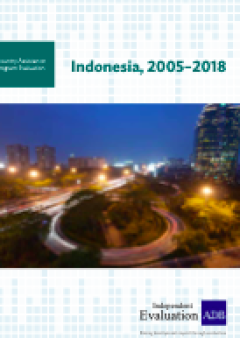
Country Assistance Programme Evaluation: Indonesia, 2005–2018
The Indonesian economy has been growing at a steady annual rate of about 5% in recent years. Indonesia has also made great progress in reducing its poverty rate, which fell below 10% in 2018, although income inequality is high and rural poverty remains a challenge. Infrastructure bottlenecks, a weak business environment, skills shortages, and low productivity and competitiveness are among the many challenges that Indonesia faces in accelerating its economic growth. Asian Development Bank (ADB) operations in Indonesia have aimed to address these development challenges and to ease some of the binding constraints on Indonesia’s growth.
This Indonesia country assistance program evaluation (CAPE) covers operations approved by ADB during 2005–2018. These were based on three country strategies over this period, all of which had inclusive and environmentally sustainable growth as their central objective. The country program in this period comprised 72 sovereign loans, 21 grants, 23 nonsovereign loans, and 122 technical assistance operations, totalling $19.3 billion. While the country strategies favored supporting a wider range of sectors, operations focused mainly on three sectors: public sector management, energy, and finance. Public sector management operations contributed to improvements in financial management by regional governments, internal audit strengthening to improve government accountability, and macroeconomic stability in the face of economic shocks. The finance sector program helped institution building, especially the establishment of the Indonesia Financial Service Authority (Otoritas Jasa Keuangan) to carry out integrated regulation and supervision of financial markets. The energy program helped to improve transmission and distribution systems and renewable energy outputs in remote parts of the country. The results were less impressive in the smaller programs of the agriculture, water, and social sectors. In part because of a lack of progress with investments in infrastructure development, a constant priority of the strategies, progress toward the objectives of inclusive economic growth and environmentally sustainable growth was unconvincing.
Keeping in view Indonesia’s medium-term plan priorities for 2020–2024 as well as ADB’s Strategy 2030, ADB should focus more on operations with a direct impact on boosting inclusive and environmentally sustainable growth. The limited capacity of subnational governments to carry out project preparation and implementation has been a drag on infrastructure development, so strengthening local government capacity will be essential. Diversifying ADB’s financing modalities to include more investment projects to complement the policy-based lending would assist this. In particular, ADB should provide greater support to address project readiness issues such as land acquisition, safeguards, and procurement that have dogged the program in the past. This will improve the design quality and results of ADB-supported investment projects. The demand for policy-based lending is expected to continue, although at a lower level than before, given the need to address the persisting development constraints. Indonesia is a middle-income country, so knowledge services and support will play a stronger role; policy-based lending needs to be well-founded on sound and in-depth knowledge work.
